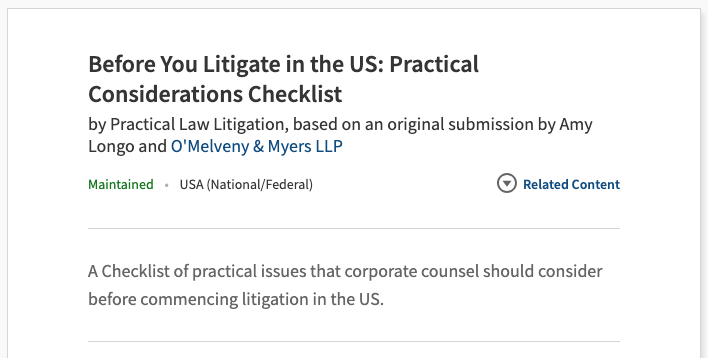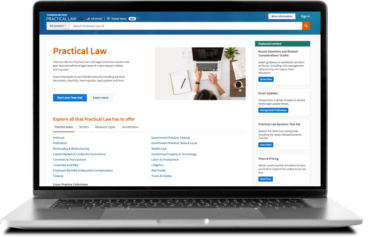In the second of three installments in this series we discuss what in-house counsel should do when litigation is happens. Also see the rest of the series to explore how to prepare for when litigation happens, as well as what in-house counsel’s role is during trial.
For an in-house lawyer, there is little more disconcerting than receiving a copy of a lawsuit filed against your company. If you have little to no experience with litigation, this can be a panic-inducing moment. Regardless of where you are on the “litigation experience” continuum, there are several “must-do” items on an in-house lawyer’s checklist:
Read the complaint.
Take a deep breath, find a quiet place, and read through the complaint. The first pass is a quick skim to get the gist of what’s alleged (and remember, just because it’s alleged doesn’t make it true). Then, a second more careful reading. This is important because the first thing you will be asked by the business is “What is the lawsuit about?” As you read through the complaint, consider the following:
1. Have they named the right parties?
2. Is the service of process proper?
3. Is there an arbitration provision or a dispute escalation process required by your contract and, if so, did they follow it?
4. Do the claims match the alleged facts?
5. Is the statute of limitations implicated in any of the claims?
Mistakes like these are common and can buy you additional time to respond or lead to dismissal of the suit.
Prepare a summary of the lawsuit.
This will help you focus and distill the issues. Include basic information like the parties to the suit; where you are being sued and the judge (or arbitration tribunal), the claims made against your company, and the types of damages alleged (monetary, injunctive, etc.). You should also start a list of potential defenses to the claims (and if you are lucky, potential counterclaims).
Identify key documents and witnesses.
As you prepare your summary, make a list of documents (contracts, emails, presentations, etc.) mentioned in the suit. You should gather those and review them asap. Are any company employees named? If so, start a list of witnesses to interview. If no one is named, think about the part of your business involved in the suit and who within that organization can help you identify potential witnesses and documents. This is all preliminary, but you must start somewhere and when you have been sued time is of the essence.
Implement a litigation hold.
Do this immediately. Litigation today is as much a game about “gotcha” over discovery issues as it is about the merits of the claim. A proper litigation hold is critical. Use the materials you prepared above to identify who you need to contact to ensure they preserve documents (and remember, “documents” is broadly defined, i.e., hard copies, soft copies, drafts, calendar entries, instant messages, etc.). Don’t worry about gathering up “every” document at this point – outside counsel will drive the collection process down the road. As the case develops, refine and update your list of people subject to the litigation hold and what records the company must preserve. Regularly remind all the people affected by the litigation hold that it is still in place and require that they affirmatively acknowledge that they received and understand their obligations.
Who needs to know?
If it’s a small claims matter, probably only a few people. If it’s major litigation, then certainly the CEO and CFO and other C-suite executives (and likely the Board of Directors). Keep in mind that it is rare that a senior executive fully understands the litigation process. You’ll probably need to provide some “Litigation 101” as you look to soothe nerves within the company. Since almost all lawsuits show up in some type of electronic docket, the media will likely receive a copy. Bring your corporate communications team up to speed early on all but the most minor litigation. If you work for a publicly traded company, contact your investor relations team and disclosure committee (you may need to file an 8K or add the claim to your next 10Q).
Does insurance cover the claim(s)?
For any material litigation, check with your insurance broker or internal team responsible for insurance to see if any of the allegations are covered by any of the company’s policies (Directors and Officers Liability, Errors and Omissions, Cyber-Risk, CGL, etc.). Check them all. And remember, it is not the headings of the claims that control whether insurance is triggered, but the factual allegations contained in the complaint. If there is any basis for coverage under the facts alleged, notify your carrier. The “duty to defend” the case is broader than the “duty to indemnify.” And if one claim is covered by insurance, the duty to defend usually extends to the other claims as well. Be watchful of how the insurance company responds to any notice you provide. If they send a reservation of rights, demand to select your own counsel as counsel selected by the insurer is conflicted.
Select outside counsel.
You probably have a “go-to” list already in place but don’t hire a firm on a knee-jerk reaction. There are many things to consider before picking counsel, including where the claim was filed, whether it involves claims based on unique areas of the law, who represents the plaintiffs, and how much/what is at stake. It may be that there is a temporary restraining order requested and you simply need to make a choice and go. But, if you have time, think hard about who the best choice would be. Time permitting, running a “request for proposal” process can be helpful. Not only will you be able to compare expertise and rates, but firms typically provide some type of detailed preview of how they would attack the case.
Can this be settled/resolved quickly?
Just because a lawsuit was filed, doesn’t mean it cannot be resolved quickly. I was involved in several cases where all it took was a phone call or two to get litigation resolved (usually involved me correcting a faulty factual premise). Would early mediation be something the other side would find appealing? Does your company just owe money and need to pay it? It’s worth spending some time before you crank up the litigation machine to 11 to see if you can quickly resolve the dispute if possible.
Who is the client?
You typically, and rightly, think of the company as your “client.” But who will you work with on settlement authority, budget, mediation, discovery, etc.? You need someone in the business to be your “client.” Work with senior management to identify that person and develop a strong working relationship going forward.
Are any confidentiality issues triggered?
Litigation is a very public process. Start thinking about any sensitive trade secrets (e.g., price information or contract terms) or reputational issues that could arise throughout the case. At a minimum you will need to get a protective order on file as soon as possible and then try to get the problematic documents sealed. Keep confidentiality issues top of mind as you go forward.
________________________________________________________________________
This checklist will help you get your arms around litigation and to get over the initial shock of a claim. Above all, don’t panic. Follow the checklist and you will be fine. Litigation is almost inevitable for companies. It’s going to happen at some point. If you subscribe to Practical Law, you have a host of litigation-related resources to help you from the day the case is filed to the day it is resolved.
 | Practical Law Checklist Checklist of practical issues that corporate counsel should consider before commencing litigation in the US. |
_______________________________________________________________________
STERLING MILLER, HILGERS GRABEN PLLC
Sterling Miller is currently CEO and Senior Counsel at Hilgers Graben PLLC. He is a three-time General Counsel who spent almost 25 years in-house. He is the author of five books and writes the award-winning legal blog, Ten Things You Need to Know as In-House Counsel. Sterling is a regular contributor to Thomson Reuters as well as a sought-after speaker. He regularly consults with legal departments and coaches in-house lawyers. Sterling received his J.D., with honors, from Washington University in St. Louis.













